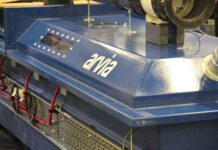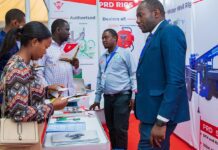Designing and constructing a new solar power project is a complex operation that requires a variety of skills and expertise. For one project in Spain, the systems integrator’s main priority was to ensure the cleanliness of the process water to avoid damage to the turbine blades used for generation, as product supplier Bürkert explains in this article
The solar-thermal plant uses parabolic-through concentrating solar power (CSP) technology. Parabolic mirrors direct the sun’s rays to a glass collector through which oil flows and gets heated up to around 400ºC. The hot oil is used to turn water into steam which is used to drive a turbine that turns the generator.
In this case the plant has two 50 MW generators and the water used in the process is groundwater. All of the impurities need to be removed before it can be used to power the turbine, otherwise the impurities would gradually build up on the turbine blades leading to corrosion and possible imbalance of the rotor.
In addition, the purified water is used to clean the mirrors regularly. If this was done with untreated water the mirrors would suffer from a build-up of contaminants, which would reduce the efficiency of the energy collection process.
The water treatment process
To meet the water quality requirements of the solar plant, a treatment process using reverse osmosis was proposed to remove the impurities from the water supply. The tier 1 contractor, responsible for the construction of the complete solar installation employed a systems integrator to deliver the reverse osmosis process. For its part, the systems integrator approached Bürkert for assistance with the design and implementation of the control system.
The reverse osmosis equipment is designed and manufactured in a skid format that simplifies the installation process and reduces the amount of time required on site. Implementing a fluid control system successfully requires a number of objectives to be met. From the measurement and control of the technical parameters to the visualisation of the process itself.
Efficient data display
Bürkert designers worked closely with the systems integrator to create a simplified yet flexible solution based around the Type 8619 multiCELL controller. One benefit of the 8619 is the ability to deal with up to six channels of data, which helps minimise the number of displays required in the installation.
Once the Type 8619 has been programmed, all the settings can be transferred to a memory card and then uploaded onto any number of similar devices. This project required two identical skids and this feature reduced the amount of time required for the setup of the second skid. This has significant benefits for OEMs, minimising any errors between builds, removing the need for programming technicians for every unit and increasing productivity.
Component count
In all, the project incorporated 12 Type 8619 multiCELL units, as well as 18 Type 8200 probe holders (8200s provide a sealed fixed mount for a range of 120mm analytical probes), used in this instance to measure pH, oxidation-reduction potential (ORP) and temperature. In addition, 16 Type 8030 paddle wheel flowmeters, 36 pressure sensors and 18 temperature sensors were also sourced from Bürkert, along with two pneumatic control cabinets and Type 8640 valve islands.
Ruben Nalda, Area Sales Manager for Bürkert in Spain, explains: “The project integrators expressed considerable satisfaction with the Bürkert solution, feeling that it offered a very cost effective and flexible approach, supported by high quality and reliable sensors.”
Once the construction of the reverse osmosis units had been completed, Bürkert offered to help with the commissioning process to ensure that all of its products were operating correctly. In fact, the intuitive design of the Type 8619 and the sensors connected to it, allowed the equipment to be correctly installed and configured by the engineers building the reverse osmosis skids.









